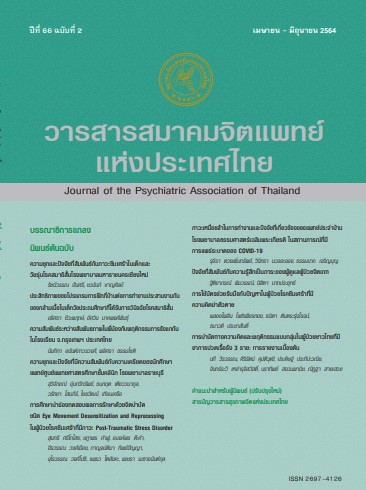The Use of Coping Cards in Depressive Patients with Suicidal Ideation
Main Article Content
Abstract
Objective: Coping card is one of strategies used to remind the safety plan for patients with suicidal ideation. It usually come in the form of index card that can be easily accessed in crisis situation. This study aimed to evaluate the use of coping card in patients with major depressive disorder in coping with suicidal ideation and also the users’ perspective.
Method: Uncontrolled longitudinal study in 21 patients with major depressive disorder and suicidal ideation was conducted at a psychiatric outpatient department, Ramathibodi Hospital. Scale for Suicidal Ideation (SSI-Thai), Depressive Symptom Index-Suicidality (DSI-SS), Patient Health Questionnaire (PHQ-9) were assessed before the study and at 4 weeks after the intervention with coping cards. Participants were introduced to coping cards and instructed to fill in coping strategies previously discussed with their clinician in the safety planning process. Descriptive and analytical statistics using Wilcoxon signed rank test, paired sample T-test and Fisher’s Exact Test were used.
Results: From baseline to the 4-week assessment, there was a reduction in the mean scores of SSI, DSI-SS and PHQ-9 with a difference of 2.40±5.83 points for SSI (p = 0.09, Cohen’s d = 0.454), 0.80± 3.11 points for DSI-SS (p = 0.02, Cohen’s d = 0.30) and 2.65±45.57 points for PHQ-9 (p<0.01, Cohen’s d = 0.63). None of the participants engaged in suicidal behaviors within the 4-week study period. Almost all of the participants kept their coping cards and remembered the coping methods in the card. A non-statistically significant difference in demographic data, SSI score and PHQ-9 score was found between coping card users and non-users. Participants found the coping card most useful for reminding them of the coping strategies including using distraction.
Conclusion: Coping card is a simple, brief intervention that is potentially helpful for dealing with suicidal ideation by objectively reminding the coping strategies. Most participants remember coping methods and have used those methods.
Key words: Coping card, suicidal ideation, major depressive disorder
Article Details
Articles submitted for consideration must not have been previously published or accepted for publication in any other journal, and must not be under review by any other journal.
References
Organization WH. Suicide rates: World Organization; 2020. [Cited 1 Dec 2020] [Available from: https://www.who.int/gho/mental_ health/suicide_rates/en/.
Department of Mental Health T. Report on Suicide rate in 100,000 population: The National Data Suicide Rates Thailand; 2560 [Cited 1 Dec 2020]. Available from: http://www.dmh. go.th/plan/suicide.
Rihmer Z. Suicide risk in mood disorders. Curt OpipPsychiatr. 2007; 20(1): 17-22.
Sokero TP, Melartin TK, Rytsälä HJ, Leskelä US, Lestelä-Mielonen PS, Isometsä ET. Suicidal ideation and attempts among psychiatric patients with major depressive disorder. The Journal of ClinicalyPsychiatr. 2003; 64(9): 1094-100.
Wenzel A, Jager-Hyman S. Cognitive Therapy for Suicidal Patients: Current Status. Behav Ther (N Y N Y. 2012; 35(7): 121-30.
Chen WJ, Ho CK, Shyu SS, Chen CC, Lin GG, Chou LS, et al. Employing crisis postcards with case management in Kaohsiung, Taiwan: 6-month outcomes of a randomised controlled trial for suicide attempters. BMCyPsychiatr. 2013; 13: 191.
Wang YC, Hsieh LY, Wang MY, Chou CH, Huang MW, Ko HC. Coping Card Usage can Further Reduce Suicide Reattempt in Suicide Attempter Case Management Within 3-Month Intervention. Suicide Life Threat Beha. 2016; 46(1): 106-120.
Bryan CJ, Mintz J, Clemans TA, Leeson B, Burch TS, Williams SR, et al. Effect of crisis response planning vs. contracts for safety on suicide risk in U.S. Army Soldiers: A randomized clinical trial. lf AffectdDisor. 2017; 212: 64-72.
Diagnostic and statistical manual of mental disorders: DSM-5™, 5th ed,(201).
Rosner B. Fundamentals of biostatistics: Seventh edition. Boston : Brooks/Cole, Cengage Learning, [2011] ©2011; 2011.
Lotrakul M, Sumrithe S, Saipanish R. Reliability and validity of the Thai version of the PHQ-9. BMCyPsychiatry. 2008; 8: 46.
Kittiteerasack P MK. Psychometric properties of the scale for suicide Ideation, Thai version (SSI-Thai Version 2014). J Psychiatr Ment Health Nur 2015;29(1): 93-102.
Beck AT, Kovacs M, Weissman A. Assessment of suicidal intention: the Scale for Suicide Ideation. f ConsuldcClilpPsycho. 1979; 47(2): 343-352.
Suh S, Ryu H, Chu C, Hom M, Rogers ML, Joiner T. Validation of the Korean Depressive Symptom Inventory-Suicidality Subscale. Psychiatry Investi. 2017; 14(5): 577-584.
Wild D, Grove A, Martin M, Eremenco S, McElroy S, Verjee-Lorenz A, et al. Principles of Good Practice for the Translation and Cultural Adaptation Process for Patient-Reported Outcomes (PRO) Measures: report of the ISPOR Task Force for Translation and Cultural Adaptation. ValuenhHealt 2005; 8(2): 94-104.
Bryan CJ, May AM, Rozek DC, Williams SR, Clemans TA, Mintz J, et al. Use of crisis management interventions among suicidal patients: Results of a randomized controlled trial. Depress Anxiet. 2018; 35(7): 619-628


